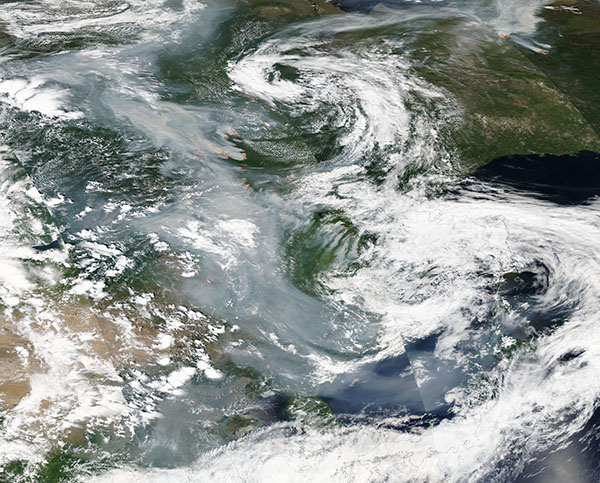Images
July 15, 2024 - Widespread Smoke across Far Eastern Russia
Tweet
Large numbers of intense, smoky fires spread across eastern Russia in the summer of 2024, shrouding the region’s skies, forests, and communities in smoke. Some of the most active areas include Yakutia (Sakha Republic), the country’s largest republic, and the Amur oblast, which borders China’s Heilongjiang province.
On July 11, the Moderate Resolution Imaging Spectroradiometer (MODIS) on NASA’s Aqua satellite acquired a true-color image of smoke pouring from many dozens, if not hundreds, of fires burning across eastern Russia. The smoke reaches far northward to the Laptev Sea (north of the edge of this image) and curls southeastward to shroud northeastern China and the Korean Peninsula. Each red “hot spot” marks actively burning fire.
On July 10, 2024, Russia’s Federal Forestry Agency reported that 44 fires were actively burning across 23,000 hectares (90 square miles) in the Amur oblast. Amur is one of eight areas in Russia that have declared a state of emergency due to fires. Other areas with large numbers of fires include Zabaikalsky Krai and the Republic of Sakha (Yakutia), the agency reported.
On July 2, the Global Fire Monitoring Center (GFMC) advised that widespread fires led to the republics of Tuva and Yakutia (Sakha) declaring states of emergency. More than 100 wildfires burned on over 300,000 hectares in Yakutia alone, while 500 active wildfires had been recorded in 18 regions in Russia’s Far East during the previous week. The Moscow Times quoted Russia’s Emergency Situations Ministry, which declared that 75 people had died and 2,200 had been evacuated from those fires.
Satellites began to detect large fires burning in Amur in mid-May. New groups of fires flared up in June and July and spread rapidly as winds picked up and temperatures warmed. Many of the fires are burning on areas rich in peat soil, which, unlike soils in most forests, serves as fuel for wildfires. When peat burns, it emits copious, dense smoke. In addition, peat fires are notorious for continuing to smolder underground even as winter snows cover the landscape in deep winter. They can then reignite in early spring as temperatures warm and snow melts.
Image Facts
Satellite:
Aqua
Date Acquired: 7/11/2024
Resolutions:
1km (4.3 MB),
Bands Used: 1,4,3
Image Credit:
MODIS Land Rapid Response Team, NASA GSFC
Tweet
Large numbers of intense, smoky fires spread across eastern Russia in the summer of 2024, shrouding the region’s skies, forests, and communities in smoke. Some of the most active areas include Yakutia (Sakha Republic), the country’s largest republic, and the Amur oblast, which borders China’s Heilongjiang province.
On July 11, the Moderate Resolution Imaging Spectroradiometer (MODIS) on NASA’s Aqua satellite acquired a true-color image of smoke pouring from many dozens, if not hundreds, of fires burning across eastern Russia. The smoke reaches far northward to the Laptev Sea (north of the edge of this image) and curls southeastward to shroud northeastern China and the Korean Peninsula. Each red “hot spot” marks actively burning fire.
On July 10, 2024, Russia’s Federal Forestry Agency reported that 44 fires were actively burning across 23,000 hectares (90 square miles) in the Amur oblast. Amur is one of eight areas in Russia that have declared a state of emergency due to fires. Other areas with large numbers of fires include Zabaikalsky Krai and the Republic of Sakha (Yakutia), the agency reported.
On July 2, the Global Fire Monitoring Center (GFMC) advised that widespread fires led to the republics of Tuva and Yakutia (Sakha) declaring states of emergency. More than 100 wildfires burned on over 300,000 hectares in Yakutia alone, while 500 active wildfires had been recorded in 18 regions in Russia’s Far East during the previous week. The Moscow Times quoted Russia’s Emergency Situations Ministry, which declared that 75 people had died and 2,200 had been evacuated from those fires.
Satellites began to detect large fires burning in Amur in mid-May. New groups of fires flared up in June and July and spread rapidly as winds picked up and temperatures warmed. Many of the fires are burning on areas rich in peat soil, which, unlike soils in most forests, serves as fuel for wildfires. When peat burns, it emits copious, dense smoke. In addition, peat fires are notorious for continuing to smolder underground even as winter snows cover the landscape in deep winter. They can then reignite in early spring as temperatures warm and snow melts.
Image Facts
Satellite:
Aqua
Date Acquired: 7/11/2024
Resolutions:
1km (4.3 MB),
Bands Used: 1,4,3
Image Credit:
MODIS Land Rapid Response Team, NASA GSFC




